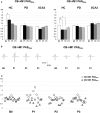Impaired Cerebellum to Primary Motor Cortex Associative Plasticity in Parkinson's Disease and Spinocerebellar Ataxia Type 3
- PMID: 28900413
- PMCID: PMC5581840
- DOI: 10.3389/fneur.2017.00445
Impaired Cerebellum to Primary Motor Cortex Associative Plasticity in Parkinson's Disease and Spinocerebellar Ataxia Type 3
Abstract
Background: Functional perturbation of the cerebellum (CB)-motor cortex (M1) interactions may underlie pathophysiology of movement disorders, such as Parkinson's disease (PD) and spinocerebellar ataxia type 3 (SCA3). Recently, M1 motor excitability can be bidirectionally modulated in young subjects by corticocortical paired associative stimulation (PAS) on CB and contralateral M1 with transcranial magnetic stimulation (TMS), probably through the cerebello-dentato-thalamo-cortical (CDTC) circuit. In this study, we investigated the CB to M1-associative plasticity in healthy elderly PD and SCA3.
Methods: Ten right-handed PD patients, nine gene-confirmed SCA3 patients, and 10 age-matched healthy controls (HC) were studied. One hundred and twenty pairs of TMS of the left M1 preceded by right lateral CB TMS at an interstimulus interval of 2 (CB → M1 PAS2ms) and 6 ms (CB → M1 PAS6ms) were, respectively, applied with at least 1-week interval. M1 excitability was assessed by motor-evoked potential (MEP) amplitude, short-interval intracortical inhibition (SICI), intracortical facilitation (ICF), and cerebellar inhibition (CBI) at the first dorsal interosseous muscle of the right hand before and after the CB → M1 PAS.
Results: The M1 excitability represented by MEP amplitude was significantly facilitated and suppressed in the HC group by CB → M1 PAS2ms and CB → M1 PAS6ms, respectively. The bidirectional modulation on MEP amplitude was absent in the PD and SCA3 groups. SICI and the baseline CBI were significantly reduced in the SCA3 group compared to those of the HC group irrespective of the CB → M1 PAS protocols. There was a significant reduction of CBI immediately and 60 min after the CB → M1 PAS protocols in the HC group but not in the patient groups. No significant change of ICF was found.
Conclusion: Corticocortical CB → M1 PAS can induce bidirectional motor cortical plasticity in M1 for healthy aged subjects. The modulation may be independent of the inhibitory neurocircuits, such as SICI and CBI, and the facilitatory mechanism like ICF. Both patients with PD and SCA3 showed impairment of such plasticity, suggesting significant functional perturbation of the CDTC circuit.
Keywords: Parkinson’s disease; cerebellar inhibition; motor cortex; paired associative stimulation; spinocerebellar ataxia type 3.
Figures



Similar articles
-
Cerebellum to motor cortex paired associative stimulation induces bidirectional STDP-like plasticity in human motor cortex.Front Hum Neurosci. 2012 Sep 19;6:260. doi: 10.3389/fnhum.2012.00260. eCollection 2012. Front Hum Neurosci. 2012. PMID: 23049508 Free PMC article.
-
Paired Associative Electroacupuncture and Transcranial Magnetic Stimulation in Humans.Front Hum Neurosci. 2019 Feb 12;13:49. doi: 10.3389/fnhum.2019.00049. eCollection 2019. Front Hum Neurosci. 2019. PMID: 30809140 Free PMC article.
-
Convergent Associative Motor Cortical Plasticity Induced by Conditional Somatosensory and Motor Reaction Afferents.Front Hum Neurosci. 2020 Oct 21;14:576171. doi: 10.3389/fnhum.2020.576171. eCollection 2020. Front Hum Neurosci. 2020. PMID: 33192405 Free PMC article.
-
Non-invasive brain stimulation as a tool to study cerebellar-M1 interactions in humans.Cerebellum Ataxias. 2016 Nov 16;3:19. doi: 10.1186/s40673-016-0057-z. eCollection 2016. Cerebellum Ataxias. 2016. PMID: 27895926 Free PMC article. Review.
-
Cerebellum in levodopa-induced dyskinesias: the unusual suspect in the motor network.Front Neurol. 2014 Aug 18;5:157. doi: 10.3389/fneur.2014.00157. eCollection 2014. Front Neurol. 2014. PMID: 25183959 Free PMC article. Review.
Cited by
-
Skeletal muscle transcriptional networks linked to type I myofiber grouping in Parkinson's disease.J Appl Physiol (1985). 2020 Feb 1;128(2):229-240. doi: 10.1152/japplphysiol.00702.2019. Epub 2019 Dec 12. J Appl Physiol (1985). 2020. PMID: 31829804 Free PMC article.
-
Broad Influence of Mutant Ataxin-3 on the Proteome of the Adult Brain, Young Neurons, and Axons Reveals Central Molecular Processes and Biomarkers in SCA3/MJD Using Knock-In Mouse Model.Front Mol Neurosci. 2021 Jun 17;14:658339. doi: 10.3389/fnmol.2021.658339. eCollection 2021. Front Mol Neurosci. 2021. PMID: 34220448 Free PMC article.
-
Functional Alteration of Cerebello-Cerebral Coupling in an Experimental Mouse Model of Parkinson's Disease.Cereb Cortex. 2019 Apr 1;29(4):1752-1766. doi: 10.1093/cercor/bhy346. Cereb Cortex. 2019. PMID: 30715237 Free PMC article.
-
Cerebral Cortical Activity Following Non-invasive Cerebellar Stimulation-a Systematic Review of Combined TMS and EEG Studies.Cerebellum. 2020 Apr;19(2):309-335. doi: 10.1007/s12311-019-01093-7. Cerebellum. 2020. PMID: 31907864
-
Human Theta Burst Stimulation Combined with Subsequent Electroacupuncture Increases Corticospinal Excitability.Evid Based Complement Alternat Med. 2020 Dec 23;2020:8824530. doi: 10.1155/2020/8824530. eCollection 2020. Evid Based Complement Alternat Med. 2020. PMID: 33424994 Free PMC article.
References
-
- Allen GI, Tsukahara N. Cerebrocerebellar communication systems. Physiol Rev (1974) 54(4):957–1006. - PubMed
LinkOut - more resources
Full Text Sources
Other Literature Sources

